When Heraclitus said, “change is the only constant”, he must’ve referred to our world in 2025 – an age where technological trends change by the week, consumer trends change by the day, and marketing trends change by the hour!
The only thing that remains constant throughout? We humans, and our primitive instincts that unknowingly or knowingly dictate all our decisions.
On our second episode of ‘Just Between You and Me’, we sit down with Mark Schaefer– internationally acclaimed speaker, and the author of Marketing Rebellion, to show you how in the end, only the most ‘Human’ company will win, and how you can learn to stay ahead of the curve by becoming one.
Ready? Let’s get down to it.
The Plan Of Action
Step 1: Acknowledge the times we live in
Step 2: Making sure you don’t get left behind
Step 3: Navigating the consumer rebellion that’s about to come
Step 4: Building a human-centric brand for today and the future
The times we live in:
Let’s start by addressing the elephant in the room- the COVID outbreak. This pandemic has arguably been the most challenging crisis of our times, which has pushed people across the globe into an abyss of uncertainty, panic, and fear. With thousands of people falling sick and/or losing their loved ones, an unprecedented rise in unemployment levels, tanking of major economies; this crisis has left despair and devastation in its wake.
It has especially preyed on the vulnerable sections of society. Those that belong to lower socio-economic strata have been disproportionately impacted by the outbreak, especially since they are at a greater risk of being infected.
We realize that there’s a cloud of uncertainty hanging over all our heads, so we need to channel our energy into finding a tiny ray of sunshine in these dark times. So, here are three silver linings that we discovered, that can help you focus on maintaining a positive outlook.
![Silver Lining to our current times]()
(A) The best opportunity for people to invest time and resources in themselves
For many, this lockdown has presented them with the time and opportunity to consume more content and learn new skills. Companies have encouraged upskill training of employees and self-learning has been the buzzword in most circles.
Given how a lot of people are staying indoors, it does not come as a surprise that time spent online has increased significantly. Visits to media sites like TV and news spiked up to 16.8%, while leading EdTech company BYJU’s, reported a whopping 200% increase in the number of new students using its product.
For marketers, this is an incredible opportunity to reimagine your social media marketing strategy. Here’s how you can capture your audience’s mindshare by focusing on 2 key questions.
![capture your audience’s mindshare]()
1. How can you help people and make their lives easier via your offering?
During these tough times, people are looking up to both local and global brands to help out in the community as much as they can. Simply saying that ‘we are all in this together and paying lip service to the idea of helping people, as opposed to actually serving the community, will only alienate your audience from your brand.
Companies who show real dedication to providing relief will be the ones that people remember in the long term. For example, Papa John’s, a major pizza chain in North America, introduced a ‘no-touch’ pizza for its customers ensuring 100% safety. They also fed the medical workers in the community, which definitely endeared them to their community members.
Many companies have started strategic marketing by advertising free subscriptions and offering new products that have been designed specifically in the context of the crisis. Zomato, a major food delivery app in India, offered its premium membership to its customers for a period of two years, for the price of one. Additionally, the proceeds from the purchase would go to delivery boys, cooks, and small eatery owners to help them survive during the pandemic. Other major companies like LinkedIn have offered free learning opportunities to help adults learn, grow, connect, and collaborate while working from home.
At InVideo, we did our own modest bit to enable people to communicate precautionary measures and support to their friends, families, communities, and customers, and let them know that they care, by launching an entire category of COVID templates that were absolutely free for everyone to use.
Create a COVID awareness video for free
By adapting your business and marketing strategy to the pandemic, not only are you staying relevant to your customers, but also achieving a long-term benefit. Think about it- you are actually getting to occupy massive mindshare with people, and form a lasting connection with your audience.
Studies in psychology have proven that the right part of our brain, which is responsible for all the narratives we remember, only registers events in the form of highlights. So, naturally, when we recollect our association/relationship with a brand, it is on the basis of our experience with them during extreme times.
For example, when the US women’s soccer team won the World Cup in 2019, Nike released an incredibly motivating and inspiring ad, which created a major buzz on social media and garnered 10M+ views on YouTube. Now, every time people will think of the brand, especially women (since it had a strong women empowerment message), they will have a fond attitude towards the brand because of what it represented through the ad.
This is why how you, as a brand, behave and treat your users in the current times, is going to be etched forever in their hearts. When things get back to normal, who do you think people will go buy from, recommend and use? Is it the brand that kept bombarding them with irrelevant sales ads or is it the one who recalibrated and went out of their way to help the community, and acknowledged that their customers are humans and not numbers on a spreadsheet?
Therefore, your marketing plan for 2020 should be firmly rooted in empathy.
2. How can you help them make progress by offering high-value educational resources?
This is your chance to empower people with knowledge and tools that they can use to make their lives better immediately, as well as in the long run.
On the professional front, one of these three things is happening to people:
- People have lost jobs and are looking to find new opportunities
- People have had to pivot and take up new responsibilities/roles to keep their jobs
- People have had to upskill rapidly in their existing roles to earn their paychecks in these difficult times.
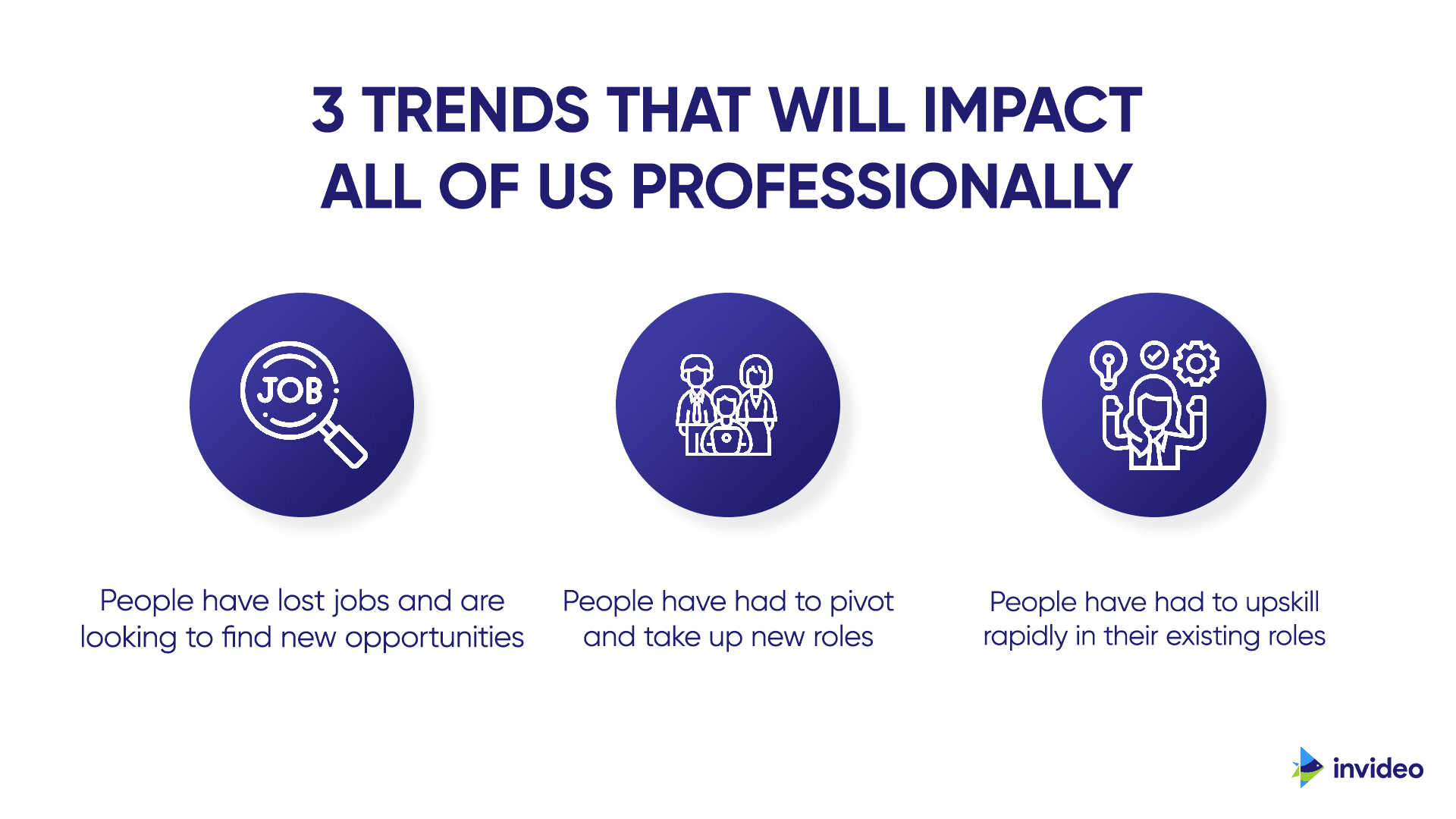 A clear relationship is emerging between learning new skills and being more employable in today’s landscape. Owing to the rapid adaptation of the market to the crisis, an increasing number of people are also having to adapt to new demands, by learning new skills. All things considered, if you are walking hand-in-hand with your audience on this journey, and helping them grow intellectually, they’ll choose your brand over another that is spamming their inbox, robocalling, or disrupting their life consistently.
A clear relationship is emerging between learning new skills and being more employable in today’s landscape. Owing to the rapid adaptation of the market to the crisis, an increasing number of people are also having to adapt to new demands, by learning new skills. All things considered, if you are walking hand-in-hand with your audience on this journey, and helping them grow intellectually, they’ll choose your brand over another that is spamming their inbox, robocalling, or disrupting their life consistently.
Having said that, are you in need of ideas on how to add value to the life of your customers?
Here are a few examples that should help you out:
Say you are a company that helps people sell things online. One possible option for you to enhance the life of your customers could be to create a high-value training module and make it accessible for free. Here’s how Oberlo made their insanely valuable course on dropshipping for free: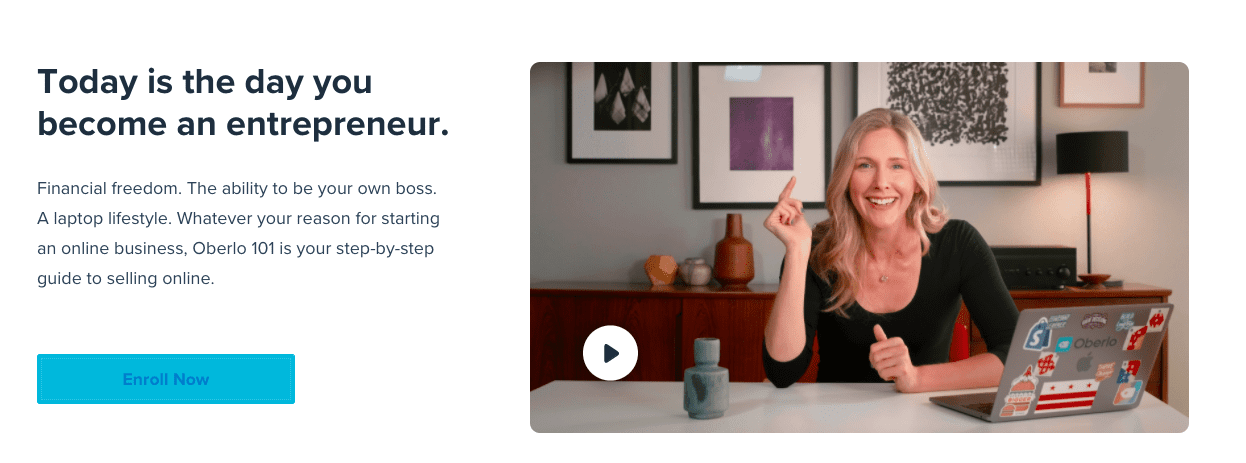
If you are a company that works on a subscription model, and you have a product that can be used to add convenience to people’s lives in these changing times, you can look at ways to offer subsidies on your product offering. As we mentioned earlier, BYJU’S, the world’s most highly valued EdTech company, offered free access to its online learning services which led to a whopping 200% increase in the number of new students using its product.

The crisis has forced companies to think on their feet and adopt new business strategies that they previously had not considered. Take the example of Cheeky Food Events, an Australian company that offers corporate team-building activities oriented around cooking. Owing to the outbreak and subsequent shutdown of offices, they suddenly lost all their business. However, they quickly adapted to the circumstances and started offering delivery-based catering to remote workforces, which instantly brought them back in business.
We at InVideo tackled this by doubling down on our high-value training resources including a brand new show in the form of ‘Just Between You and Me with Steve Dotto’ as well, creating comprehensive guides on marketing that can give our users actionable frameworks and blueprints that they can apply to their own businesses.
Register to catch all the episodes LIVE
Having established how this outbreak is an opportunity for us to learn and grow, let’s look at how we can use this time as a training period for the future.
(B) A training ground and a pit stop to get ready for the future
This period is a classic example of how rapidly the marketing and business landscape can evolve. The dizzying pace at which brands can go from being wildly popular to absolutely irrelevant is hard to keep up with. Hence, this is the ideal training opportunity for businesses to understand how the marketing strategy for the future would look, and what role would their businesses play in the future.
There are two important lessons to remember as we look to the future:
![Infographics on Key lessons for the future]()
1. What’s super relevant today can be completely irrelevant tomorrow
Marketing is becoming more and more contextual with the advent of technology and innovation; which is why the surest strategy for survival is to embrace change and walk hand-in-hand with it. Brands are coming out with extremely relevant campaigns that are rooted in the current context of the world, to keep their followers engaged and not come off as tone-deaf.
Here is a creative from popular contraceptive manufacturer Durex, asking people to stay indoors. The graphic is issuing a message in the public interest but is also evoking an emotional response from the viewer, who is hence encouraged to spend time with their partner. 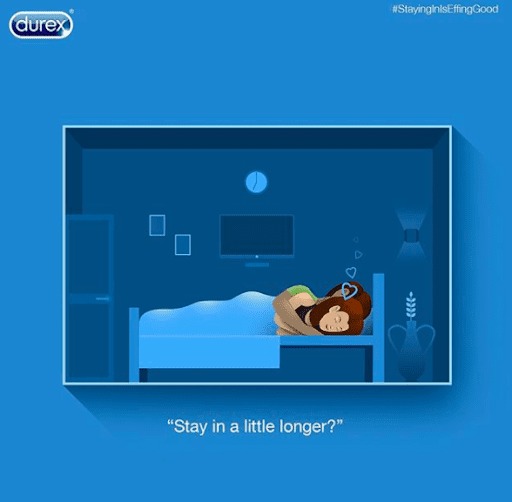
Of course, there is no beating Netflix when it comes to staying relevant. It came out with the popular mini-series ‘Coronavirus Explained’ on its platform, which received massive viewership.
Bottom line: Marketing strategies of the future will need to be extremely agile, contextual and relevant for it to have any impact whatsoever on people.
2. Only human-centric companies will survive
People don’t want to be spammed with promo material that is insensitive and not relevant. Companies that introduce a human touch to their marketing strategy, will be the frontrunners of the future. A great example of a marketing strategy that solves a real pain point, is that of Audible, an audiobook service by Amazon. It has started offering free streaming of stories to its users, to help them teach, engage, and keep their children occupied as schools remain shut in most places. They have enhanced their human connection with their users, by helping them solve a very pertinent problem.

(C) There is no playbook and this is your chance to take on the bigger players
Marketers will unanimously agree that this pandemic has leveled the playing field for brands. It’s a fascinating time for marketing strategists, to watch everyone try to figure out which marketing strategy will work and which does not. The big brands are no better off since all their 2020 plans and product launches have been put on indefinite hold. Well, this is your time to shine. Here are 3 ways for you to stand out right now.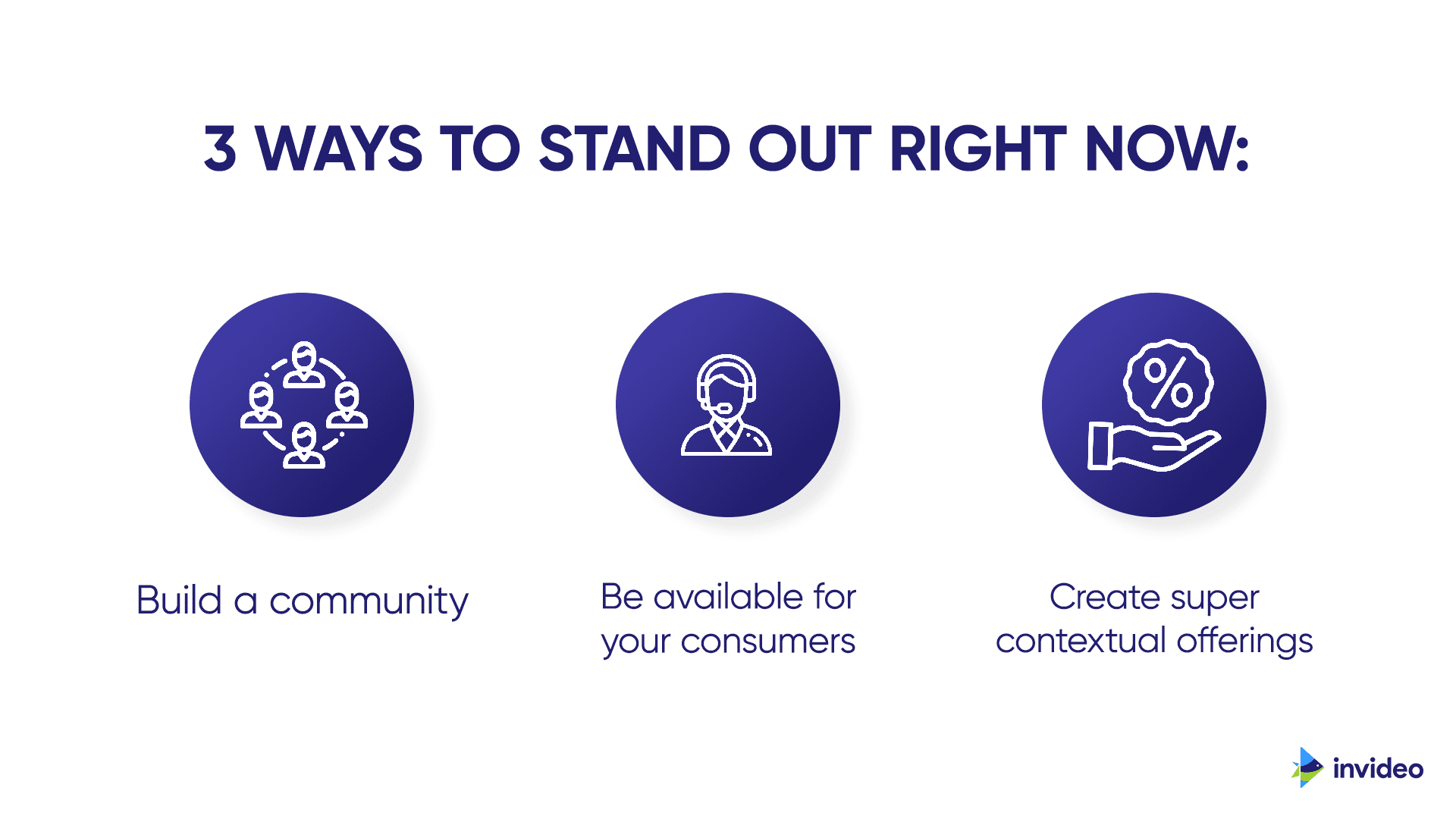
1. Build an engaged community
In these times, your marketing objective needs to go beyond generating sales. There hasn’t been a better time to build your own community and offer to help out in whichever way possible. You can provide them free access to some of your services, encourage them to share their quarantine stories with you, or even organize an educational event for them. Here’s a great example of how Mari Smith– the queen of Facebook marketing- went out of her way to help out her community:

Check out the original post here
We’ve nurtured and built a community ourselves here at InVideo which has grown to more than 7500 members in less than a year, and the way our users support and help each other every day is incredible to watch.

2. Be available for your community and make it super convenient for them to reach out to you
Social solidarity is a powerful tool and there is great comfort in having someone simply listen to your troubles. Make sure you are available to your community, as a friend, as a guide, and maybe even as an expert. You can consider introducing a 24*7 helpline for people who are struggling. A great example is that of Maybelline, which has joined forces with Crisis Text Line to offer support to its community by allowing them to reach out to a Crisis Counselor for free, 24*7. 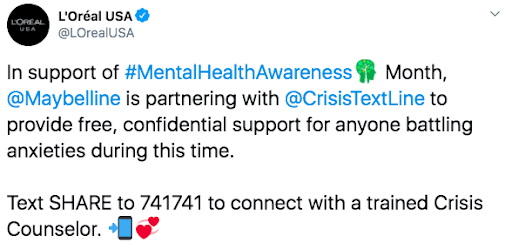
3. Create products/offerings that are super relevant and contextual to the current times
A contemporary marketing strategy should be all about staying relevant, as mentioned before. If you are an apparel brand, focus more on comfort wear and loungewear, which have been selling out like hot cakes during the lockdown. You can also create printed, breathable masks for kids and adults. If you are a cosmetics brand, reorient your marketing strategy to highlight your skincare products, like hand creams, night creams, and essential oils. Cult.fit, a popular chain of fitness studios, has populated its online applications with content for those looking to work out from home. Their live training videos have been a massive hit.
The Big Question: Who is going to be Left Behind?
What’s worth understanding is that the crisis will dissipate in 3 steps:
Phase 1: Only essentials are a priority
This is the teeth of the situation which we are currently in. The lockdown period where the only priority for most is restricted to sourcing absolute essentials.
An effective way of thinking about what constitutes essentials is to think about Maslow’s Hierarchy Of Needs. 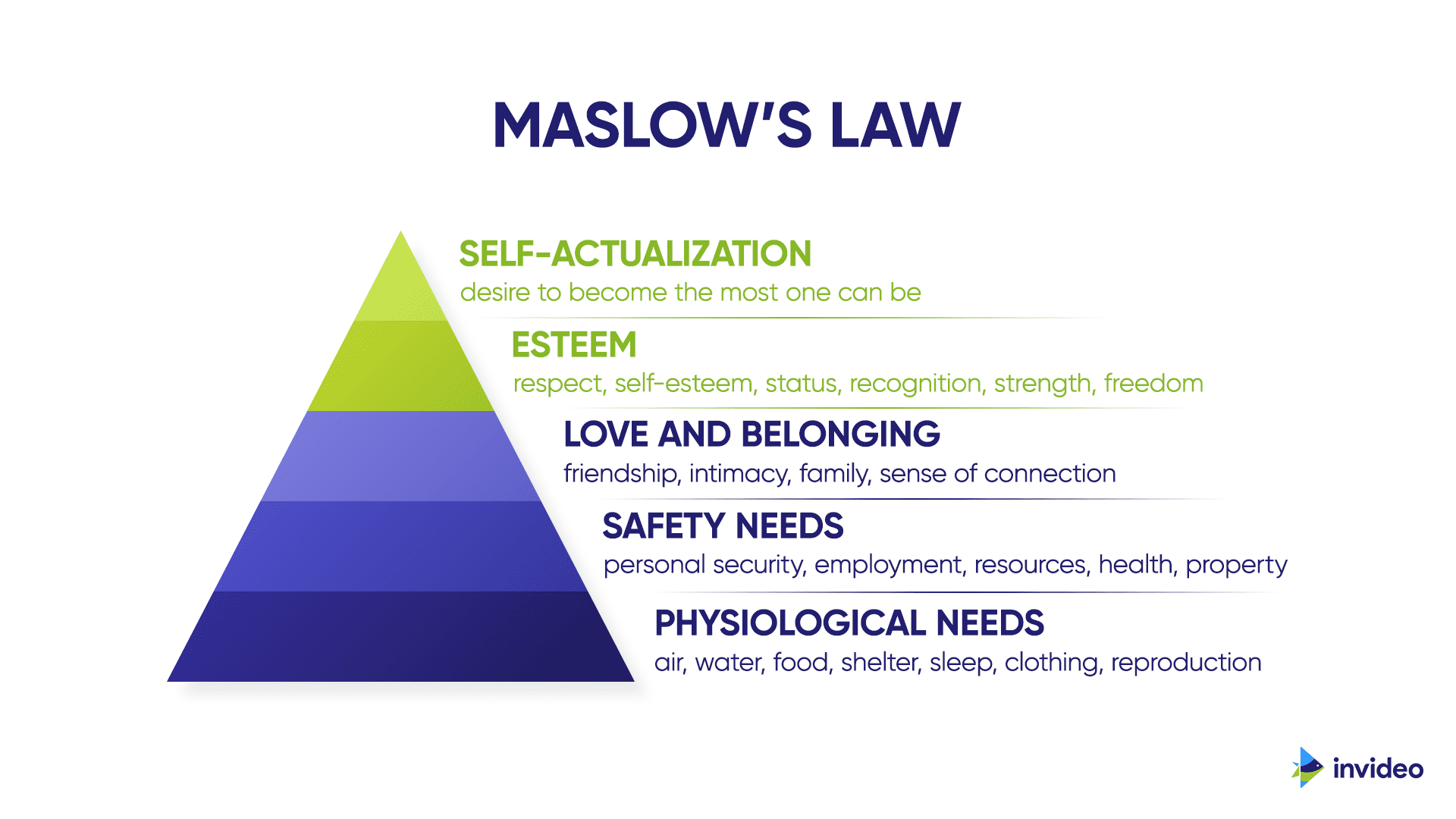
As a brand, if you are currently serving the needs at the bottom of the pyramid, then you better double down and make sure you keep doing what you are doing. In case you are a brand that is catering to the top of the pyramid, you have to rethink how you can contextualize your services and start focusing on fulfilling the more rudimentary needs of your customers.
For example, luxury perfume brands like LVMH quickly repurposed their resources and factories to start producing sanitizers and disinfectants in bulk. Companies like Nike and Adidas have had to close down all their retail stores, but they are focusing on educating their customers to stay indoors and work out from home. The customers can still buy sportswear online and use it for indoor workout sessions.
Mark also gives his own example, about how as a marketing expert, he suddenly felt that his service was catering to needs at the top of the pyramid and his clients simply could not pay him anymore. He then focussed his attention to serving the needs that constitute the bottom of the pyramid, by coming up with his Pandemic Playbook. It’s a free e-book containing key strategies for businesses to survive during this pandemic. It advises them on how they should be “waking up” customers in order for their marketing plan to succeed.

Phase 2: New habits are forming
This pandemic has restricted us to the confines of our home, and things will never go back to the way they were before. Businesses need to prepare to engage with new consumer habits that are being shaped by this virus outbreak. Post-pandemic, many are going to find themselves still confined to their corona bubble. These people need to be woken up.
For example, if you are a travel business, once the flights start to operate again, you have to wake up your customers and convince them that traveling has not been canceled. Come up with trip ideas that will prioritize the safety of your customers by suggesting travel destinations that have been declared corona-free. It is important to remind your customers that they can still do the things that they once enjoyed while ensuring that they are taking the necessary safety precautions.
![Post Pandemic - Mark Schaefer]()
Phase 3: Structural changes
If you look at any historical crisis, for example, the 9/11 attacks, you will realize that we are inevitably going to witness structural changes in our society. Completely new behaviors will emerge, which will require you to adapt your business to cater to those new patterns of demands.
For example, there is a meal kit delivery company called Hello Fresh, which delivers ingredients and a recipe to your doorstep, which you can cook with your family. Mark explains how his family has come to love this process of cooking their own meals and trying out new recipes, and don’t want to go back to the same old grocery shopping. As a result, Hello Fresh is now emerging as a competitor to the local grocery store.
So, you will have to take a step back and ask yourself- here’s how we used to connect with our customers before, but, is that still relevant? If the answer is no, you have got to revamp your marketing strategy. This is primarily because there has been a shift from revenue to relevance.
For example, if you are a real estate agent, your business is probably not doing well right now. So, what can you do? How can you connect with your community? One way is to reinvent yourself and be of service to your community. You can think of collecting resources that can help out people who are struggling with their housing situation at the moment. Help inform your community about available homeless shelters, free legal consultants whose services can be availed by those who can’t pay rent, the rights of tenants and landlords during a crisis, and so on. The driving force isn’t necessarily creating new sales, but making an enduring connection that you can leverage at a later time to boost your business.
What all of this ultimately boils down to is introducing a human, personal, and compassionate touch to your marketing strategy 2020. The most human company wins and the ones that don’t adapt, get left behind! This is why we are witnessing the expeditious growth of digital companies, who understand the importance of changing with the times at a much deeper level; whereas the traditional companies are falling behind in the race.
Are we at the brink of a consumer rebellion?
In the history of marketing, whenever companies have abused customer trust, they have had to face a rebellion. So far, there have been three such rebellions that we can learn from.
![consumer rebellion]() The First Rebellion – The End of Lies
The First Rebellion – The End of Lies
The first rebellion dates back to the days of early advertising and marketing. Back in those days, companies were prone to making remarkable promises to their customers, which were often misleading and untrue. What’s outrageous is that they almost always got away with the lying. Then came a series of magazine articles in the 1920s in Collier’s magazine, which exposed many such false claims and informed its readers about the harmful effects of the products. For example, there were pills advertised as weight loss supplements, that proved to have terrible side effects and were actually harmful to users. Soon enough, there was a major consumer backlash which sparked the first rebellion. As a result, new legislation was passed by the Federal Trade Commission, which put in place checks and balances for these companies to prevent them from making any false promises.
![The First Rebellion - The End of Lies]() The Second Rebellion – The End of Secrets
The Second Rebellion – The End of Secrets
With the advent of the internet, we ushered in a new era of information. Suddenly, brands found their customers being more informed about their products than they would have liked. The customers could now read between the lines and legislation mandated complete disclosure of all aspects of the product. For example, all brands now had to clearly mention all the ingredients that went into the making of their product The second rebellion was, therefore, a movement to advocate for complete transparency, and companies were no longer permitted to keep any secrets from the consumers.
![The Second Rebellion - The End of Secrets]() The Third Rebellion – The Loss of Control
The Third Rebellion – The Loss of Control
What was characteristic of the traditional ways of marketing, before the age of the internet, was that the brand image of any company was strictly controlled by the brand itself. Every brand had a dedicated PR arm which was responsible for disseminating all the information about that brand. The customer only had the company’s word to take, on the utility of a product. The internet disrupted this completely, by making information accessible to anyone, from anywhere, about anything. Suddenly, Apple products were being reviewed, dissected and discussed on chat forums, social media, and everywhere else on the internet. Product reviews and many other new forms of PR emerged, which saw the customers carrying the brand message forward and letting other people know what they know. Brands no longer had complete control over their own image.
Marketing today is at a stage where it cannot simply manipulate people into buying a product. It has to empathize with its customers, join them on their walk of life and brainstorm how they can add more value to their lives. This has to be done in a way that the customers would be tempted to tell their friends and family about the brand. Your promotional strategy needs to be more responsive, rather than dictatorial. Unless brands transform to become more human-centric, they will quickly become irrelevant to people.
How Do I Build a Human-centric Brand for Today and the Future?
Mark points out that there’s a distinct shift of power in marketing from brands to consumers. To survive amidst cutthroat competition, brands have to prioritize their customer’s needs above all. Not just that, he’s put together an incredible manifesto, which is a survival guide for businesses in these troubled times. We have also thrown in some corresponding marketing plan examples for you to draw inspiration from:
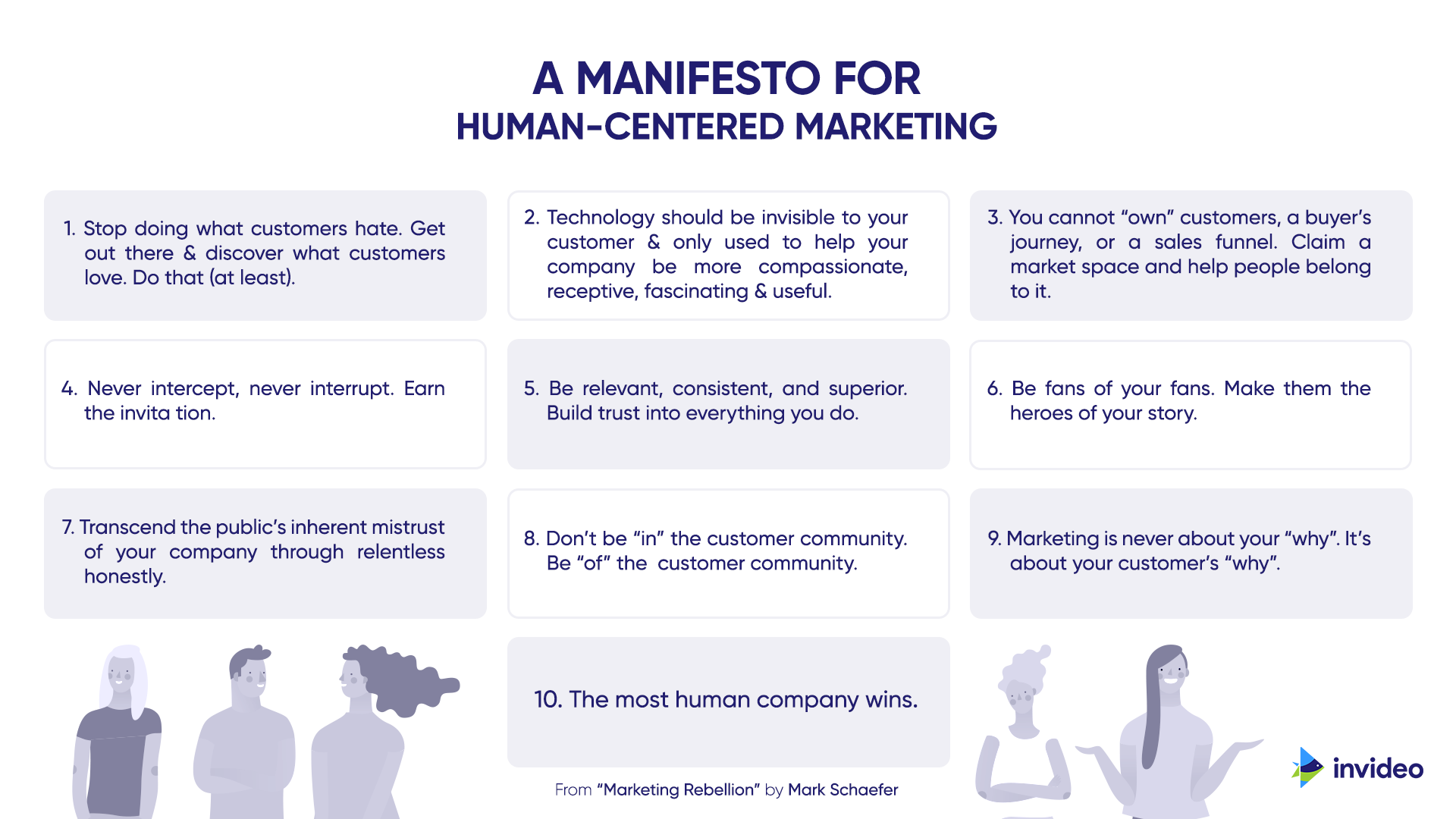
1. Stop doing what customers hate. Get out there and do what customers love
Your customers will definitely not enjoy relentless spam mails in their mailbox. Stop bombarding them with promo material and instead consider going out and helping your community. This will endear you to your customers who want to see brands helping out during these troubled times. For example, Decathlon’s trademark is how it lets its customers try and test everything they’re about to buy- from sports equipment to gear. This urges consumers to resonate with the brand, try out what they have to offer since it’s a risk-free zone (and rather fun), and gives them the full power of making a self-informed choice.
2. Technology should be invisible to your customer and only used to help your company be more compassionate, receptive, fascinating, and useful
Recent studies show how customers are increasingly preferring chatbots over real human interactions. This is because bots can be used to help people get to the FAQ that they want, in the quickest time possible. This ends up reducing turnaround time on chat support systems by eliminating the need for a human to be present, without affecting the experience. Technology, here, is being molded to become more efficient, receptive but without losing the human element.
3. You cannot own customers, a buyer’s journey or a sales funnel. Claim a market space and help people belong to it
Going back to the example of Hello Fresh, the meal kit delivery company, it’s worth noticing how they don’t try to position themselves as the hot new thing in the food industry. Instead, their market strategy is to claim a market space by offering not just a product, but an experience – that of cooking new recipes with your family. Anyone who identifies with this experience and takes joy in it, will belong to their product and eventually become loyal customers who keep coming back.
4. Never Intercept, never interrupt. Earn the invitation
Consider that you have a cleaning company. Now, it wouldn’t be wise to keep spamming your customers with your offerings while they are trying to cope with this crisis. You cannot strongarm your way into their household. You have to earn their invitation. What you can do is highlight pain points that you feel your customers might relate to, and then provide them with the solution that you can offer them. Highlight your sanitization service which is essential for the safety of your customer’s family. If your product is something that appeals to them and will solve a real problem for them, you will receive that invitation soon enough.
5. Be relevant, consistent, and superior. Build trust into everything you do
If you look at the trajectory of brands like Nike or Apple, you will agree that their products have always been of the best possible quality and they have consistently tried to remain relevant. That is what you need to work on. Create a superior quality product that earns you the trust of your users, and then it is all about holding on to that trust by remaining relevant with time. Update features, bring out new launches, and be open to experimentation.
Here’s an example of how Apple beautifully captures and communicates its core values,
6. Be fans of your fans. Make them the heroes of your story
Every day, we are hearing extraordinary stories about people in the community who are going out of their way to help out in the midst of this outbreak. Delivery boys, grocery store workers, doctors and nurses, cleaners, and so many more people in the community are being hailed as heroes. Give them their due credit and highlight their stories so that your customers are aware of your connection with the community. Facebook and Google have offered free ad slots to small businesses to help them survive this pandemic, and they have also run adverts saluting the frontline workers who are our first line of defense against the crisis.
For example, smartphone giant Vivo paid a tribute to medical professionals by dedicating a video to them by using the hashtag #HeroesWhoCare – while also pledging to donate thousands of masks to these ‘heroes’.
7. Transcend the public’s inherent mistrust of your company through relentless honesty
How does a brand gain back trust in its customers after losing it once? We’ve seen many brands have their ups and downs in the past, yet most of them survive and manage to rebuild their reputations- only with relentlessly accepting that they faltered, and being evidently willing to bear the brunt and correct its mistake.
For instance, Volkswagen, after its 2015 widely spoken of scandal where it was found to be installing software in its car engines that could detect test scenarios by monitoring things like speed, air pressure, engine operation, and even the positioning of the steering wheel. This meant they were rigging the stationary tests, and the result? The engines emitted nitrogen oxide pollutants up to 40 times above what is allowed in the US.
This lifted the trust of many consumers that relied on the brand, as investigations, legal cases and constant inquiries were slammed.
What worked in Volkswagen’s favor was their brutal honesty and acceptance of their mistake, fighting the case till the end, and coming out of it. Although it took a staggering number of years for the brand to re-establish itself and come out with a clean slate, it finally did- and that’s what matters.
8. Don’t be ‘in’ the customer community. Be ‘of’ the customer community
A popular example of leveraging your resources to redirect the public’s attention to an important cause, is Reese Witherspoon’s production company, Hello Sunshine. She started the venture in 2016 to address the gender imbalance in the mainstream entertainment industry. Her female-centric narratives in movies and television shows garnered huge support from the cinephile community, and she achieved massive success. She was suddenly one ‘of’ us, telling our stories and ensuring that women get the representation they deserve.
9. Marketing is never about your why. It’s about your customer’s why
As a brand, when you ask yourself ‘how to create a marketing plan?’, the answer should always come from the demand of your audience. If you are marketing a product, ask yourself why your customers will buy it. Identify a real pain point for your customers, and market your product in a way that it solves a very real problem for them.
10. The most human company wins
Online marketing strategies need to be personalized, authentic, and evocative. If you are a company that is reaching out to your community, adding the human touch to your marketing, helping out essential workers, or setting up a resource center for people who are struggling in your community, you are already eons ahead of your competitors. Your marketing activities should be all about appearing more human and more authentic.
Bottom line: Anything that facilitates human-centered interactions and connections will stand the test of time, while everything else will become irrelevant.
Our recommendation: Embrace the new wave of change and get to do what is ultimately right for your customer. Shift your focus from impressions to humans and they’ll make sure they stick with you- no matter how hard the times.
This post was written by Sarika and edited by Abhilash from Team InVideo


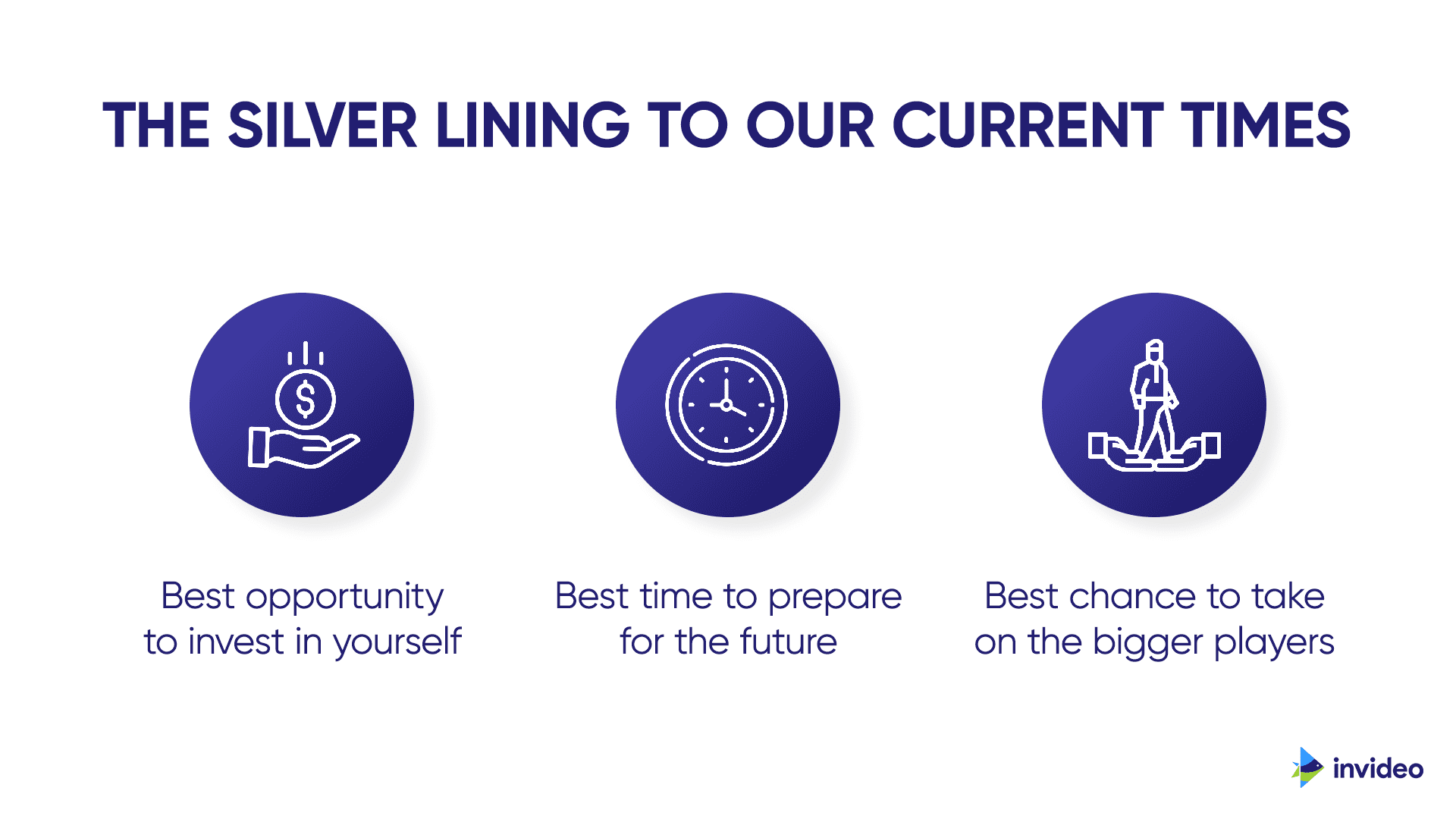
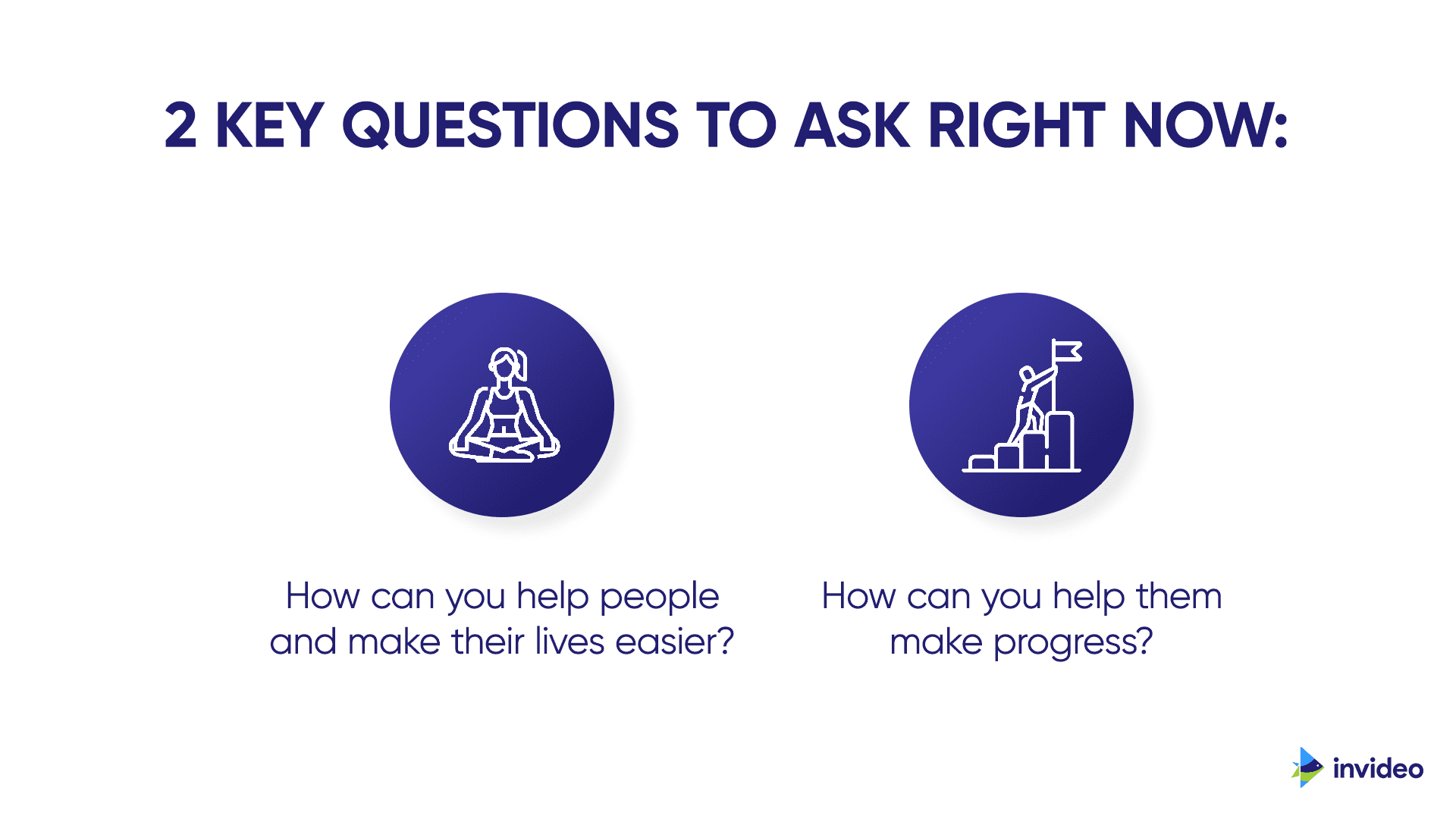

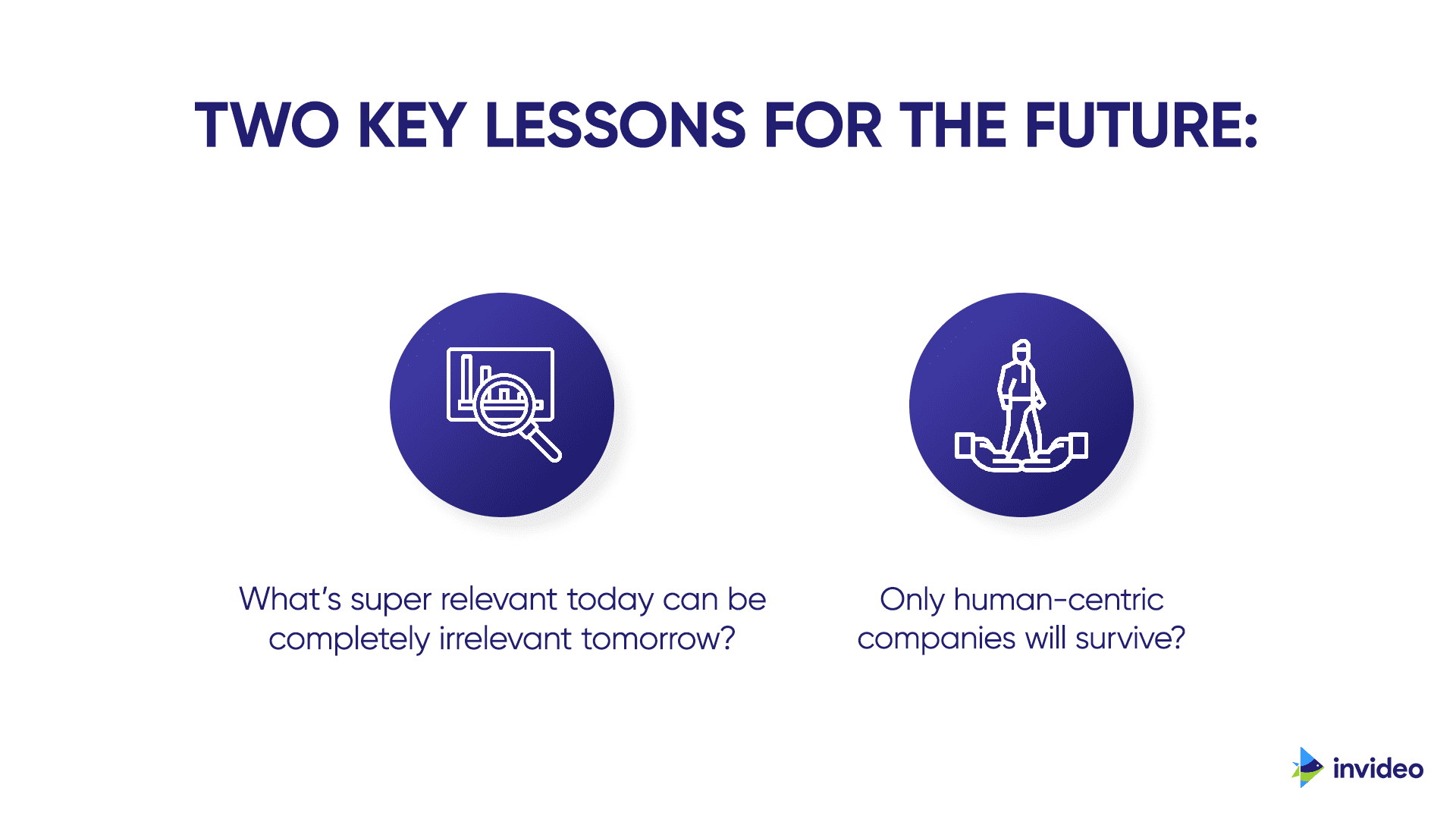
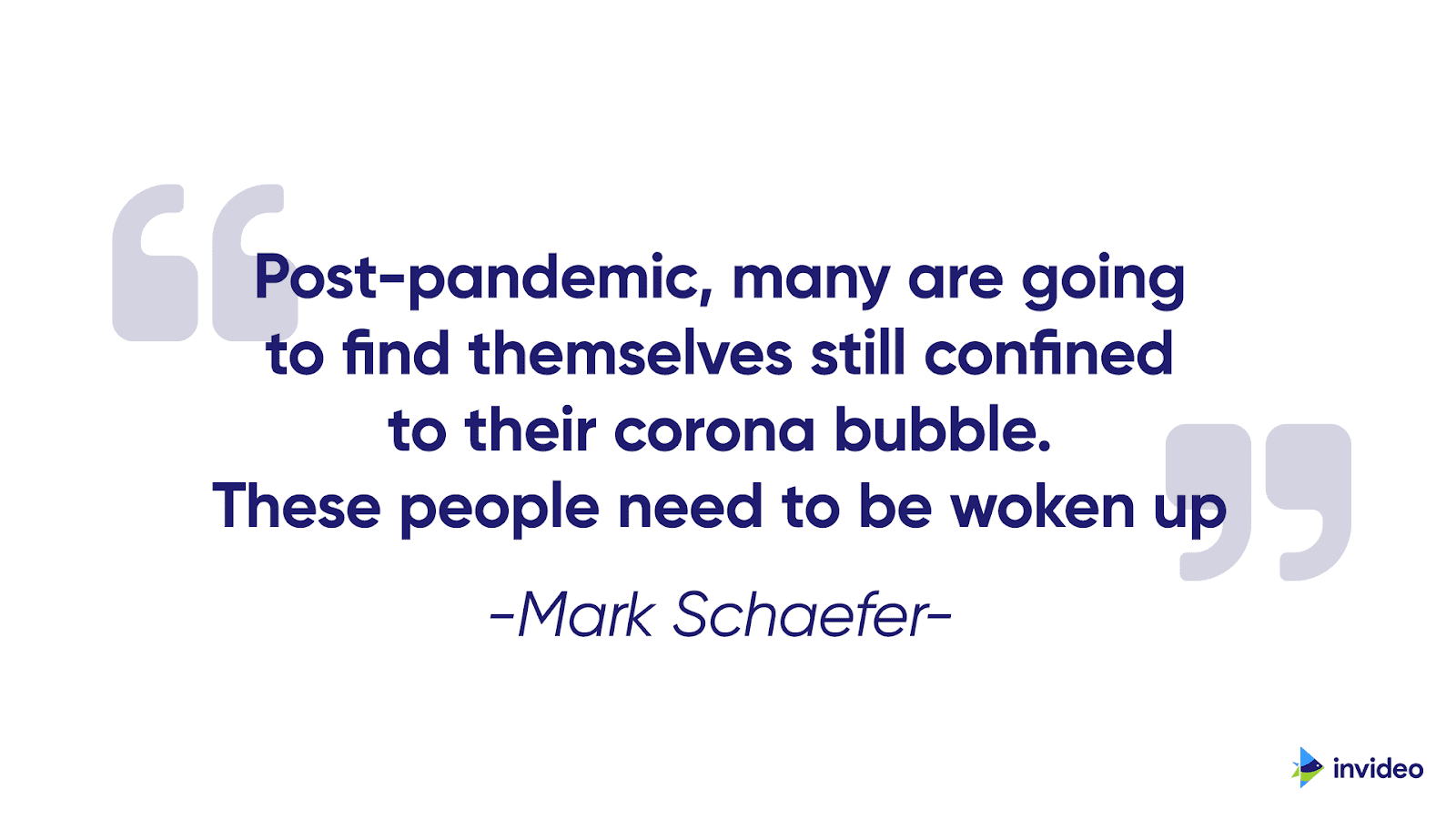

 The First Rebellion – The End of Lies
The First Rebellion – The End of Lies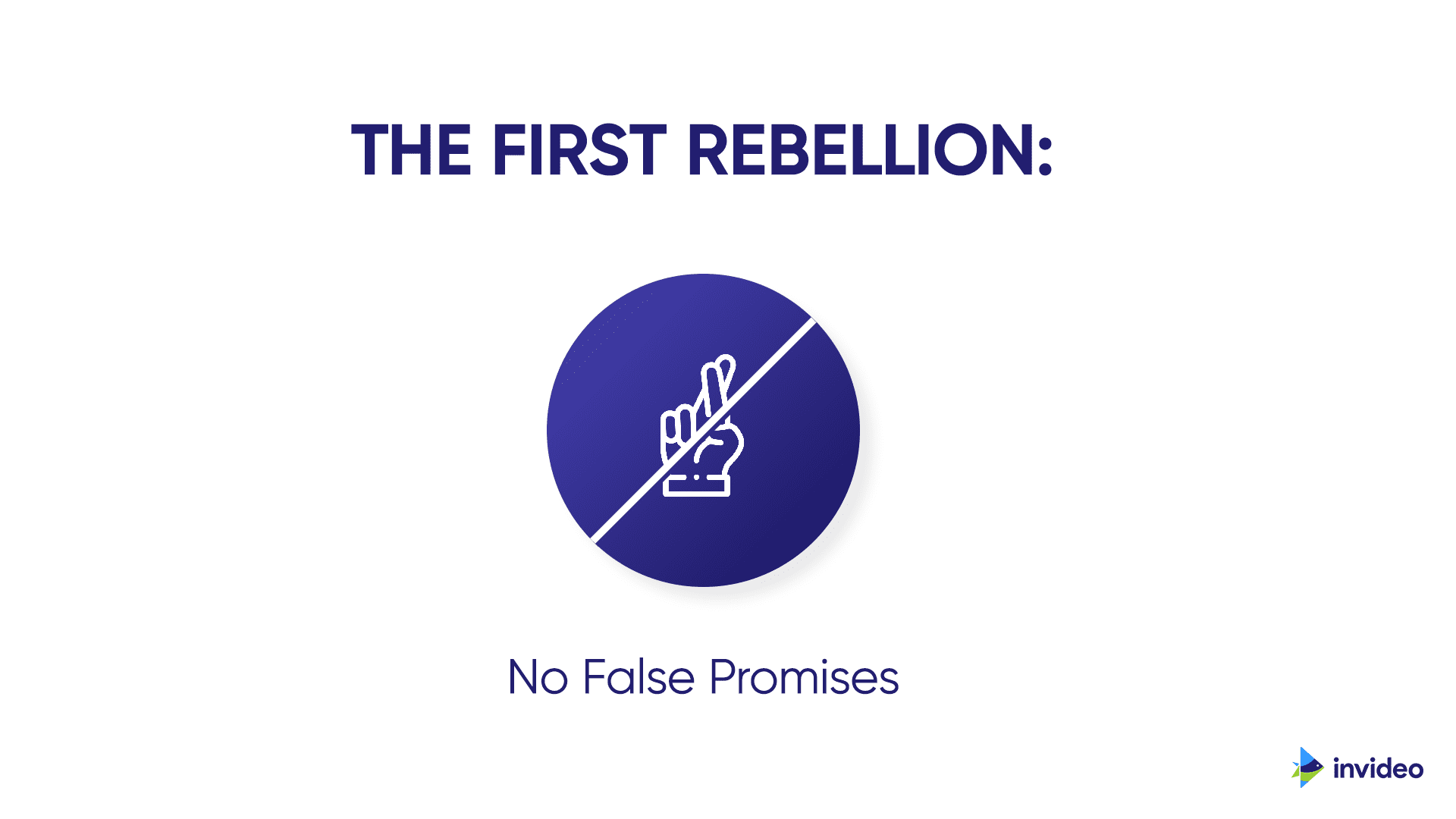 The Second Rebellion – The End of Secrets
The Second Rebellion – The End of Secrets 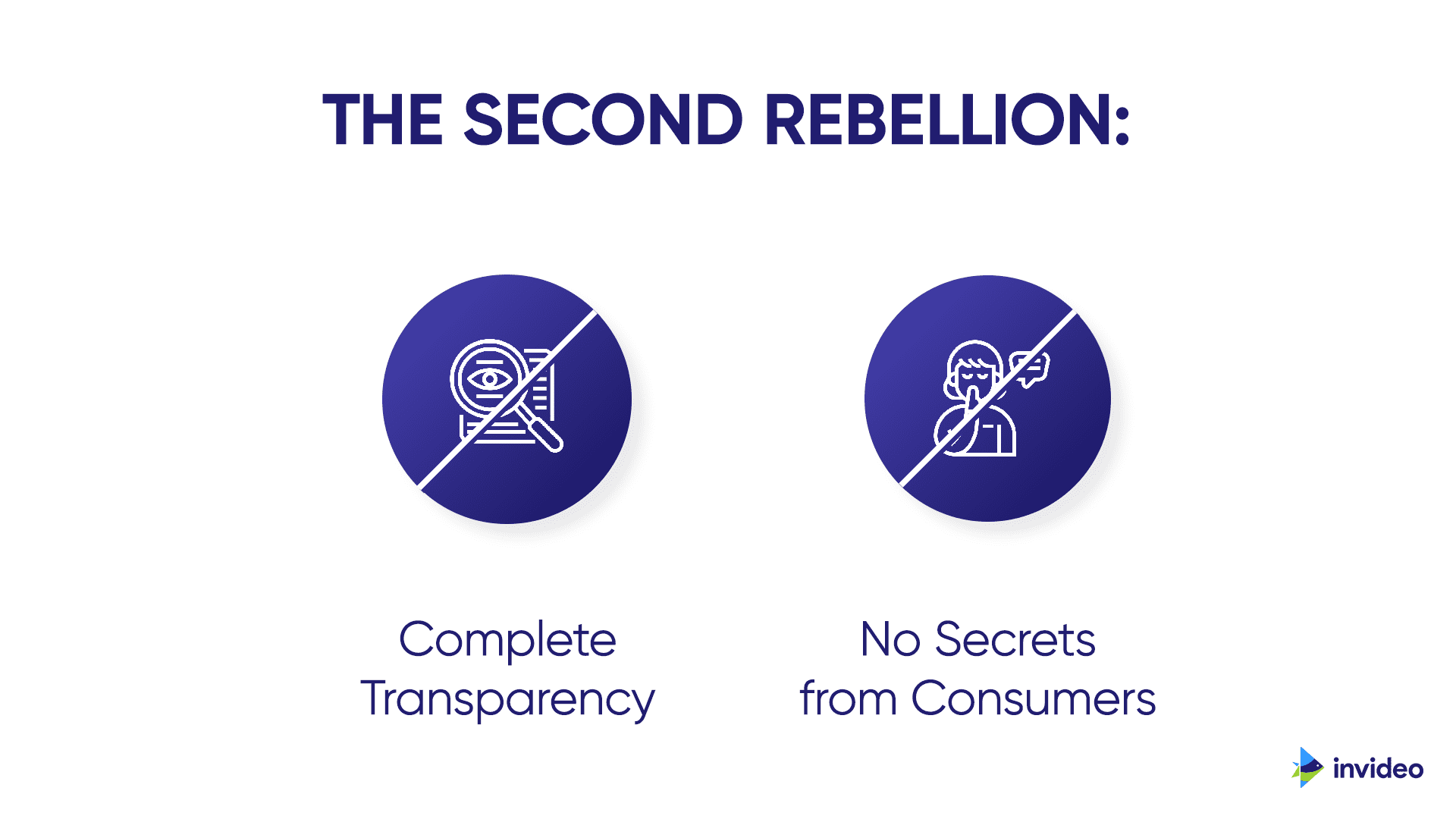 The Third Rebellion – The Loss of Control
The Third Rebellion – The Loss of Control
